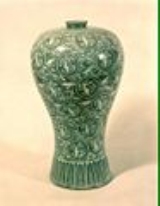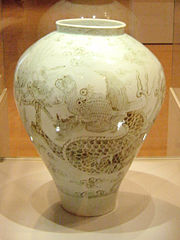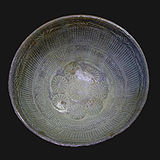
Korean pottery
Encyclopedia

Earthenware
Earthenware is a common ceramic material, which is used extensively for pottery tableware and decorative objects.-Types of earthenware:Although body formulations vary between countries and even between individual makers, a generic composition is 25% ball clay, 28% kaolin, 32% quartz, and 15%...
from around 8000 BC.
Three Kingdoms pottery

Goryeo Dynasty porcelain

Goryeo
The Goryeo Dynasty or Koryŏ was a Korean dynasty established in 918 by Emperor Taejo. Korea gets its name from this kingdom which came to be pronounced Korea. It united the Later Three Kingdoms in 936 and ruled most of the Korean peninsula until it was removed by the Joseon dynasty in 1392...
Dynasty (918–1392) achieved the unification of the Later Three Kingdoms
Later Three Kingdoms
The Later Three Kingdoms of Korea consisted of Silla, Hubaekje , and Hugoguryeo . The latter two were viewed as heirs to the earlier Three Kingdoms of Korea, which had been united by Silla, even though Hugoguryeo has little to do with Goguryeo...
under King Taejo
Taejo of Goryeo
Taejo of Goryeo was the founder of the Goryeo Dynasty, which ruled Korea from the 10th to the 14th century. Taejo ruled from 918 to 943.-Background:...
. The works of this period are considered by some to be the finest small-scale works of ceramics in Korean history.
Key-fret, foliate designs, geometric or scrolling flowerhead bands, elliptical panels, stylized fish and insects, and the use of incised designs began at this time. Glazes were usually various shades of celadon, with browned glazes to almost black glazes being used for stoneware and storage. Celadon glazes could be rendered almost transparent to show black and white inlays.
While the forms generally seen are broad-shouldered bottles, larger low bowls or shallow smaller bowls, highly decorated celadon cosmetic boxes, and small slip-inlaid cups, the Buddhist potteries also produced melon-shaped vases, chrysanthemum cups often of spectacularly architectural design on stands with lotus motifs and lotus flower heads. In-curving rimmed alms bowls have also been discovered similar to Korean metalware. Wine cups often had a tall foot which rested on dish-shaped stands.
Joseon Dynasty porcelain

Joseon Dynasty
Joseon , was a Korean state founded by Taejo Yi Seong-gye that lasted for approximately five centuries. It was founded in the aftermath of the overthrow of the Goryeo at what is today the city of Kaesong. Early on, Korea was retitled and the capital was relocated to modern-day Seoul...
, (1392–1910) ceramic ware was considered to represent the highest quality of achievement from imperial, city, and provincial kilns, the last of which were export-driven wares. This was the golden age of Korean pottery, with a long period of growth in imperial and provincial kilns, and much work of the highest quality still preserved.
Wares evolved along Chinese lines in terms of colour, shape, and technique. Celadon, white porcelain
Joseon White Porcelain
Joseon white porcelain or Joseon baekja refers to the white porcelains produced during the Joseon dynasty .-History:White porcelains were preferred and praised than any other porcelains during the time to represent Korean Confucian ethics such as frugality and pragmatism...
, and storage pottery were similar, but with slight variations in glazes, incision designs, florality, and weight. The Ming influence in blue and white wares using cobalt
Cobalt
Cobalt is a chemical element with symbol Co and atomic number 27. It is found naturally only in chemically combined form. The free element, produced by reductive smelting, is a hard, lustrous, silver-gray metal....
-blue glazes existed, but without the pthalo blue range, and the three-dimensional glassine
Glassine
Glassine is a very thin and smooth paper that is air and water resistant. It is translucent unless dyes are added to color it or make it opaque...
colour depth of Ming Dynasty
Ming Dynasty
The Ming Dynasty, also Empire of the Great Ming, was the ruling dynasty of China from 1368 to 1644, following the collapse of the Mongol-led Yuan Dynasty. The Ming, "one of the greatest eras of orderly government and social stability in human history", was the last dynasty in China ruled by ethnic...
Chinese works.

Buncheong
Buncheong ware, or Punch'ong ware is a form of traditional Korean stoneware, with a bluish-green tone. Pots are coated with a white slip, and decorative designs are painted on using an iron pigment. The style emerged in the early Joseon Dynasty, largely replacing celadon in common use...
or stoneware.
After the prolonged fall of the Ming dynasty, immigration of some Chinese master potters occurred in southern coastal Korea. Qing
Qing Dynasty
The Qing Dynasty was the last dynasty of China, ruling from 1644 to 1912 with a brief, abortive restoration in 1917. It was preceded by the Ming Dynasty and followed by the Republic of China....
colouring, brighter and almost Scythian
Scythian art
Scythian art is art, primarily decorative objects, such as jewelry, produced by the nomadic tribes in the area known classically as Scythia, which was centred on the Pontic-Caspian steppe and ranged from modern Kazakhstan to the Baltic coast of modern Poland and to Georgia...
in enamel imitation, was rejected by Korean potters, in favour of simpler, less decorated wares in keeping with a new dynasty that built itself on military tradition.
Generally, the ceramics of this dynasty is divided into early, middle, and late periods, changing every two centuries, approximately; thus 1300 to 1500 is the early period, 1500 to 1700 the middle, and 1700 to 1900–1910 the late period.
The wares began to assume more traditional Korean glazes and more specific designs to meet regional needs. This is to be expected, as the Scythian art influences were of the former dynasty. The rise of white porcelain
Joseon White Porcelain
Joseon white porcelain or Joseon baekja refers to the white porcelains produced during the Joseon dynasty .-History:White porcelains were preferred and praised than any other porcelains during the time to represent Korean Confucian ethics such as frugality and pragmatism...
occurred as a result of Confucian influence and ideals, resulting in purer, less pretentious forms lacking artifice and complexity.
In 1592 during the Japanese invasion of Korea, entire villages of Korean potters were forcibly relocated to Japan permanently damaging the pottery industry as craftsmen had to relearn techniques because the masters were gone.
Export porcelain
Nearly all exports of Korean ceramics went to JapanJapan
Japan is an island nation in East Asia. Located in the Pacific Ocean, it lies to the east of the Sea of Japan, China, North Korea, South Korea and Russia, stretching from the Sea of Okhotsk in the north to the East China Sea and Taiwan in the south...
, and most were from provincial coastal kilns, especially in the Busan
Busan
Busan , formerly spelled Pusan is South Korea's second largest metropolis after Seoul, with a population of around 3.6 million. The Metropolitan area population is 4,399,515 as of 2010. It is the largest port city in South Korea and the fifth largest port in the world...
area. Export occurred in two ways: either through trading and the voluntary immigration of potters, or through outright invasion and theft of pottery and the forced relocation to Japan of families of potters who made the wares. The method of sending paper models of ceramics to Japan, having them approved and then having them manufactured began in the late 17th century, most often for the masters of Japanese Tea Ceremony
Japanese tea ceremony
The Japanese tea ceremony, also called the Way of Tea, is a Japanese cultural activity involving the ceremonial preparation and presentation of matcha, powdered green tea. In Japanese, it is called . The manner in which it is performed, or the art of its performance, is called...
.
Kilns

Modern kilns are either electric or gas-firedre electric kilns.
Centers For studying Korean ceramics
- Department of Ceramics at the College of Art and Design, Ewha Woman's University in SeoulSeoulSeoul , officially the Seoul Special City, is the capital and largest metropolis of South Korea. A megacity with a population of over 10 million, it is the largest city proper in the OECD developed world...
- Korea Ceramic Foundation (KOCEF)
External links
- The Asian Art Museum, An excellent Korean ceramics collection
- The Art of Korean Potters Exhibit
- Korean History
- Over 120 pictures of Korean Pottery from the Freer Gallery
- Koryo dynasty
- Korean ceramics Details of an exhibition at the Smithsonian InstitutionSmithsonian InstitutionThe Smithsonian Institution is an educational and research institute and associated museum complex, administered and funded by the government of the United States and by funds from its endowment, contributions, and profits from its retail operations, concessions, licensing activities, and magazines...
- Cultural Assets of Korea
- Comprehensive Archaeological Bibliography of Korean Pottery
- Talks on the Korean impact on Japanese ceramics (Archived 2009-10-31)
- Joseon Dragon vase (Archived 2009-10-31) with softer watery-blue glaze and naturalistic brush-strokes
- From the Fire: Contemporary Korean ceramics International Arts Ceramic Artists exhibition
- Mountain Dreams: Contemporary Ceramics by Yoon Kwang-cho — Philadelphia Museum of Art exhibition

